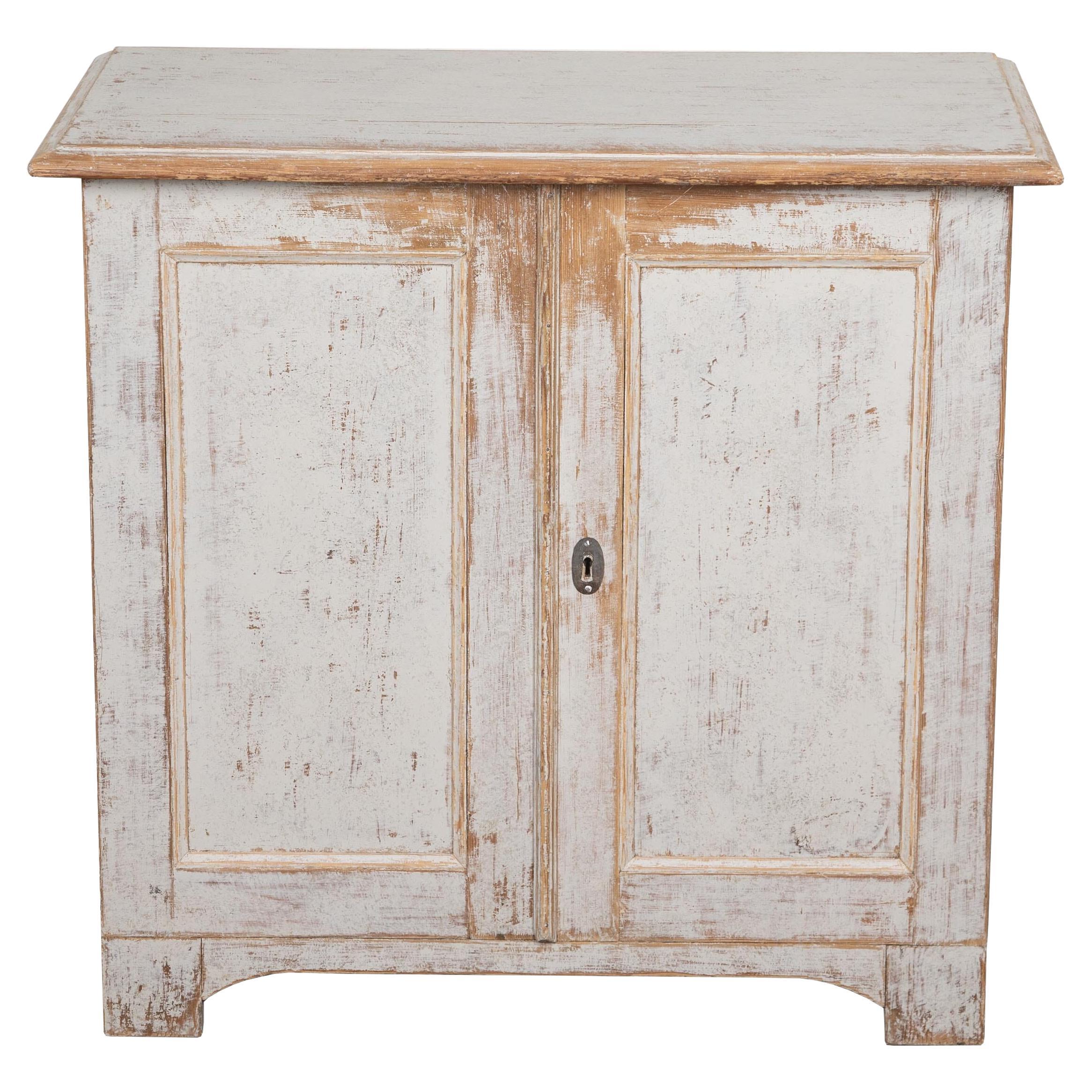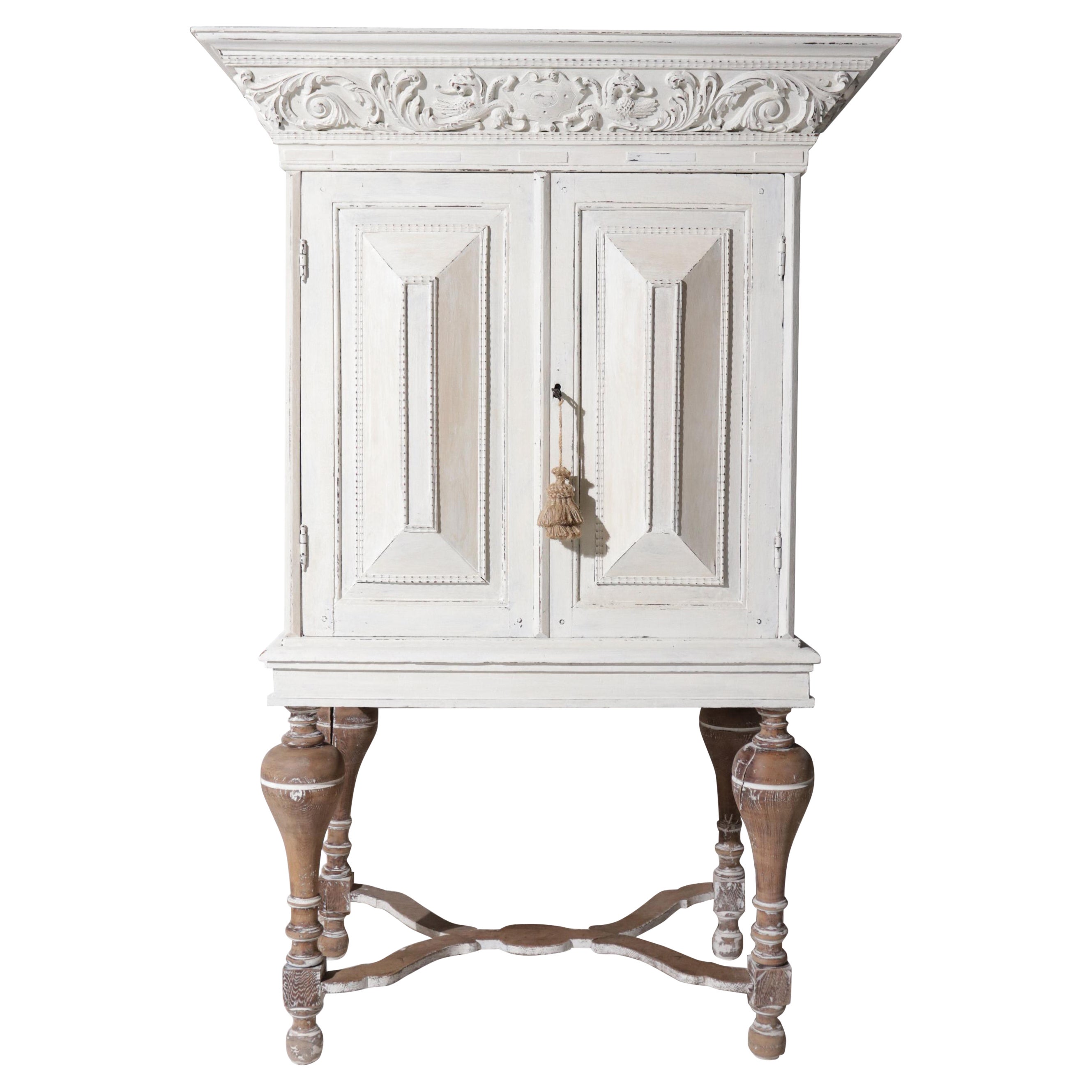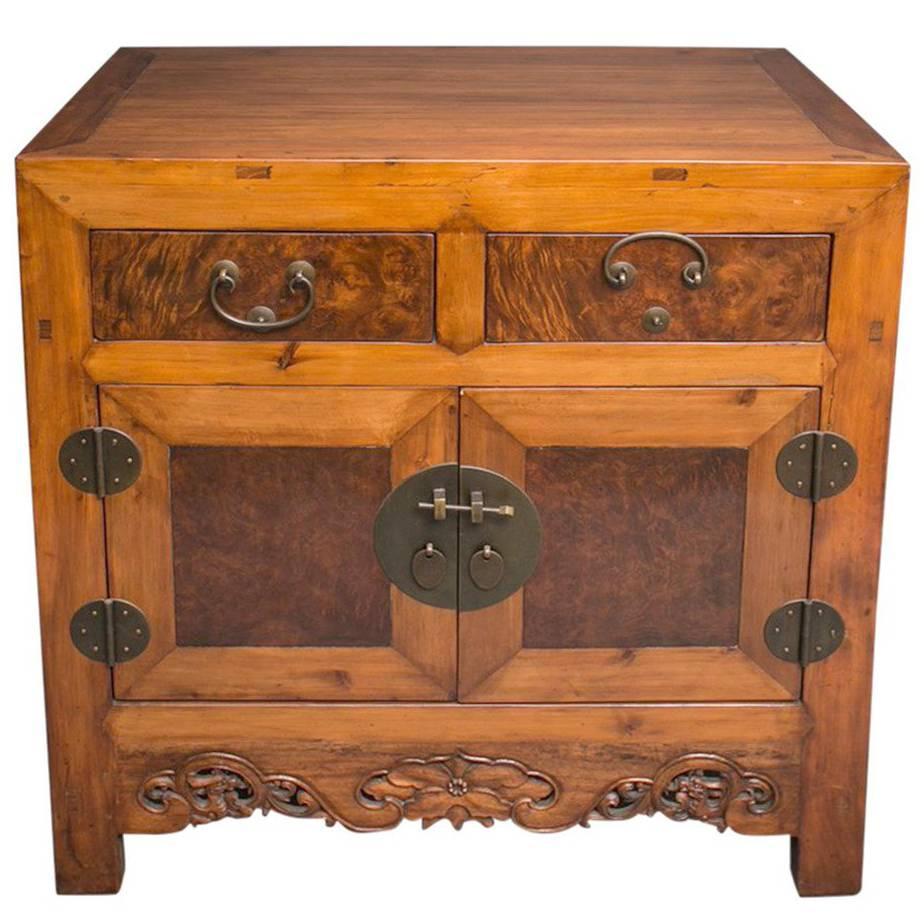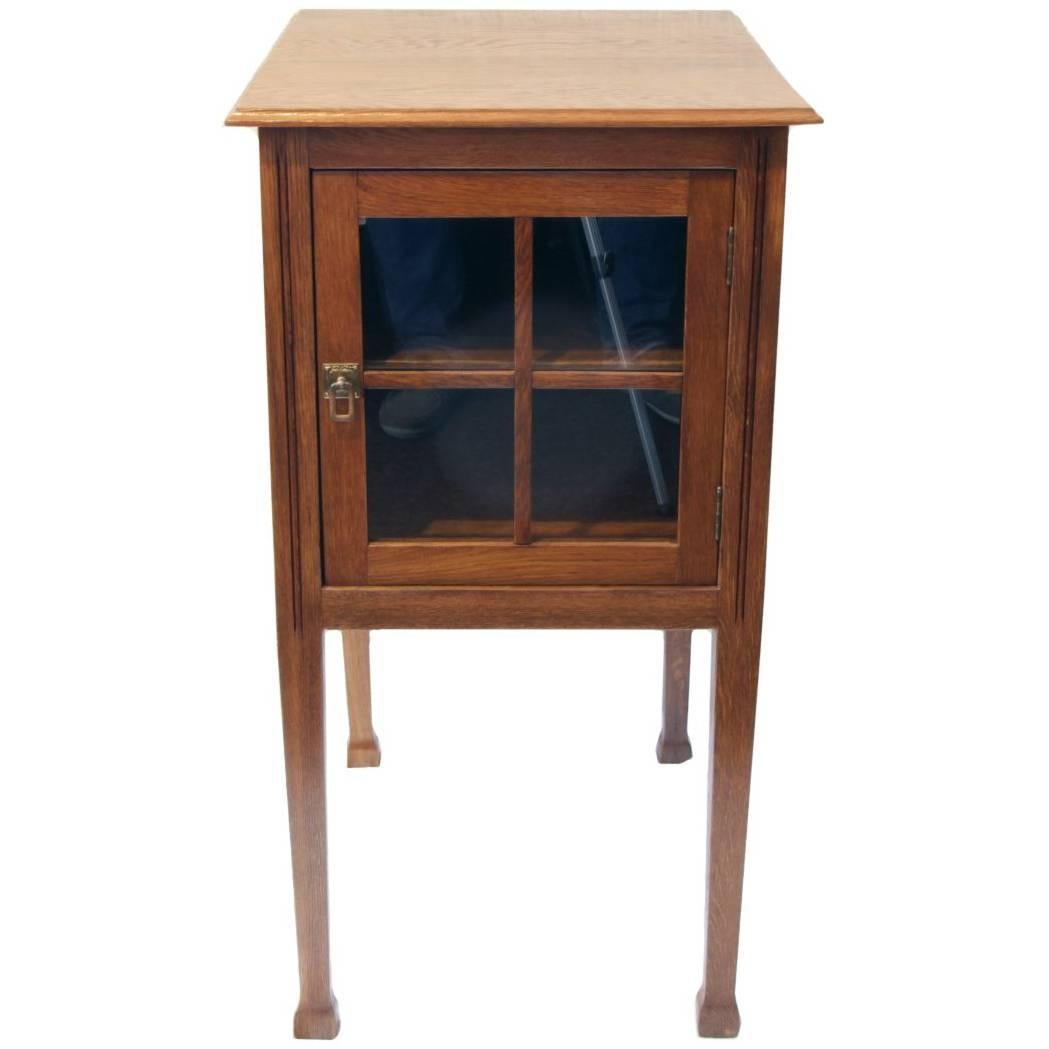Items Similar to Cabinet Spice Small Oak Cedar Snakewood Fruitwood Cushion Geometric Moulding
Want more images or videos?
Request additional images or videos from the seller
1 of 20
Cabinet Spice Small Oak Cedar Snakewood Fruitwood Cushion Geometric Moulding
About the Item
- Particularly fine example with deep cushion and geometric mouldings.
- Atmospheric piece with character
- Secret drawers add intrigue
A rare mid-17th century oak and cedar spice cabinet with geometric and cushion mouldings. The front with a single door with a deep central cushion moulded geometric panel in cedar and other exotic woods. Framed by four oak geometric moulded panels within a cedar and snakewood surround enclosing a pair of oak geometric panels above and below and two vertical oak geometric panels on each end. Later brass escutcheon, probably 19th century the lock also and the hinges original. The edge of the cabinet decorated in punchwork. The sides and top with fine medullary ray detailing. The fitted interior with original brass handles and fittings. The upper drawers fitted with secret drawers. The central compartment with three small drawers with original drop handles. On bun feet. Original keys.
Just purchased more information to follow.
- Dimensions:Height: 15.16 in (38.5 cm)Width: 14.77 in (37.5 cm)Depth: 10.83 in (27.5 cm)
- Style:Baroque (Of the Period)
- Materials and Techniques:
- Place of Origin:
- Period:1650-1659
- Date of Manufacture:circa 1650
- Condition:Repaired: see description. Wear consistent with age and use.
- Seller Location:BUNGAY, GB
- Reference Number:1stDibs: LU3867325956802
About the Seller
5.0
Vetted Seller
These experienced sellers undergo a comprehensive evaluation by our team of in-house experts.
Established in 1985
1stDibs seller since 2018
85 sales on 1stDibs
Typical response time: 12 hours
- ShippingRetrieving quote...Ships From: BUNGAY, United Kingdom
- Return PolicyA return for this item may be initiated within 7 days of delivery.
More From This SellerView All
- Chest of Drawers Oak Cushion Moulding Panelled Bun Feet Drop Handles VernacularLocated in BUNGAY, SUFFOLKLovely, characterful example of a good late-17th century oak chest of drawers with an exceptional lustrous and rich colour and patin...Category
Antique 1660s English Baroque Commodes and Chests of Drawers
MaterialsOak
- Chest of Drawers Chest Commode Architectural Facade Enclosed Renaissance CedarLocated in BUNGAY, SUFFOLKA museum quality, English, Late-Renaissance, cedar enclosed chest of drawers with exceptional snakewood, walnut & oak with an architectural or façade front This is the most sophisticated English model of chest of drawers conceived as a cabinet piece with an architectural front intended to disguise the drawers. This chest exhibits the mastery of English Late-Renaissance, cabinet making combining woods prized for their exoticism, color and beautiful figuring with carving and moulding in different ornamental patterns to simulate materials found within an architectural façade...Category
Antique Early 17th Century European Renaissance Commodes and Chests of D...
MaterialsCedar
- Cassone Venetian 16thc Renaissance Cedar Original Stand Neptune Armorial UnicornLocated in BUNGAY, SUFFOLKA large, museum-quality, late-16th century, cedar, Venetian, cassone on its original stand ; the sea creature ornament probably drawn from De la Cosmographie Universelle, livre III, engraving 1550-1568 • This is the only, known, cassone of this type retaining its original stand. • The collection in Italy that it originally came from was a palazzo that it had reputedly been in for generations of the same family and this most likely why the stand has survived. • The decoration is very unusual, and delightful in the array of sea creatures depicted. The connection of the region with the sea is very strong. • The inner lid is very practical and can be used for display or serving. The interior offers masses of storage space which is particularly suitable for textiles being cedar which repels moths. • The cassone is a beautiful, rich colour and has developed a lustrous patina. • The cassone is Illustrated & discussed in discussed in ‘Woods in British Furniture Making’, (Bowett) c13 Provenance: Private collection, Mayorca. Private collection, Italy Related to: Cassone in V&A collection, no 4886-1858 Width 177 cm., 70 in., Height 87 cm., 34 ½ in. Depth 68 cm. 26 ½ in. With lid open 155 cm., 61 in “Late 16th and 17th century, London inventories confirm that cypress wood chests were relatively common in prosperous households. In 1598 there was a cypress chest in the hall of John Mason, a vintner, valued at 50 shillings. It was the most expensive piece of furniture in the house. Similarly there was a ‘fair cypress chest’ in the great chamber of Adrian Moore, haberdasher, in 1618, and a cypress chest worth £ 9 in the hall of Thomas Willis, a clotherworker in 1630. The chests were sometimes described as ‘great’ or ‘small’ but not otherwise described – presumably they were familiar to the compilers of the inventories. They were placed in halls, chambers and parlours, places where they would have been on prominent view. It is noteworthy that only the chests were imported and not, apparently, the wood. “ (p282, Cypress, Woods in British Furniture making) The decoration is very unusual, and delightful in the array of sea creatures depicted. The connection of the region with the sea is very strong. I have never seen one of these chests on its original stand. The collection in Italy that it came from was a palazzo that it had reputedly been in for generations of the same family and this most likely why the stand has survived. In practical terms, the stand makes the chest a comfortable height to use. The exterior of the chest is a beautiful, mellow colour and has developed a lustrous patina. The top comprises three planks faced with a shallow, cleated, moulded edge nailed on. The front retains its original hasp and lockplate and, as is commonly found, the lock has been removed but, unusually the original ring hinges have survived. The top opens to reveal an inner lid with ring hinges and a brass ring, revealing a large open storage compartment below, the bottom lined with an old fabric. The underside of the lid retains its original penwork and pierced decoration. The central panel depicts sea creatures, sharks, flatfish, monster fish, sea horses, Neptune and mermaids, probably drawn from De la Cosmographie Universelle, livre III, engraving 1550-1568. The panels either side depicting a crown, the sun and unicorns amongst stylised floral sprays. The surrounding naive penwork border features repeats of three naked ladies in the sea, a man wearing an animal mask with two dogs in a forest and a huntsman with two dogs. The floor of the inside of the cassone is upholstered in an 18th century red and yellow striped woven textile the colours of the Catalan flag. The front is decorated with pierced, silhouettes of beasts, trees and figures. The sides are plain with iron carrying handles. On its original stand, with similar decoration, and bearing a cartouche which would have been decorated with the arms of its original owner. Italian, last quarter of the 16th century. Condition Report : Old repair to bottom left moulding of top. Some hairline cracks to top. The hasp, lockplate and ring hinges are original, the lock has been removed. Handles probably 18th century. The inner lid was probably added in the 18th century and supporting mechanism in the 19th century. Exceptional original, lustrous colour and patina. Measures: Width 177 cm. 70 in., height 87 cm. 34 ½ in., depth 68 cm. 26 ½ in. The cassone was the principal piece of furniture in 16th century, Italy. These chests were made as bridal gifts for nobles and aristocrats from cedar specifically for storing their much prized and valued hangings, clothing and linens, as the wood repels moths and the sweet fragrance delicately scents fabrics. Consquently the cassone, as in this example might be decorated with the family coat of arms or with depictions of virtue and edifying episodes from the Bible. A young woman could not be allowed to enter marriage without some instruction. Later, many cassoni were taken apart so that the decorated front panel could be hung as a painting. The stand of this cassone has a cartouche that would have contained a painted coat of arms in the centre which shows that it was conceived for a noble family. Such cypress or cedar chests, incised in bas relief and pyrographically engraved, have long been associated with Venice and typically have a naïve decoration on the exterior. Literature: The 'cypress chests' containing 'arras, counterpoints, costely apparel, tents, and canopies, fine linen, Turkey cushions...Category
Antique 16th Century Italian Renaissance Cabinets
MaterialsCedar
- Casket, Box, Cabinet, Architectural, Ebonized, Alabaster, Secretdrawers, MalinesLocated in BUNGAY, SUFFOLKAn early 17th century, Flemish, Malines, ebonized and alabaster cabinet with removable sliding sides revealing secret drawers 12” long. The ebonized top with two carved alabaster ...Category
Antique 1630s Belgian Baroque Cabinets
MaterialsAlabaster
- Contador Cabinet Original Stand Rosewood Vinhático Portuguese Brass TremidosLocated in BUNGAY, SUFFOLKA STRIKING, MUSEUM QUALITY, BAROQUE, PORTUGUESE BRAZILIAN, ROSEWOOD & VINHÁTICO CONTADOR OR CABINET ON STAND WITH BRASS MOUNTS - Masterpiece of carved ornament, with tremidos or flut...Category
Antique 1650s Portuguese Baroque Cabinets
MaterialsBrass
- Chest Small Walnut Spanish Carved Cypress Tree Flowerhead 31" long 16 1/4" highLocated in BUNGAY, SUFFOLKMuseum Quality, Small, Spanish, Walnut Chest With Rare Cypress Tree Carving, A Single Plank Top & Outstanding Colour & Patina - Rare carved decoration of cypress trees alongside more traditional Spanish ornamentation - Rare small size - Exceptional quality and condition - Exudes the charm and character of Spanish furniture The single plank top with deep, crisply carved moulding below. The front with two panels, each carved with a large flowerhead roundel with carved cypress trees interposed. On later trestle base. The escutcheon and lock removed. Original pin hinges. The interior with original candle box and lid. The back with two large 'X's and the date '1849' painted in black, probably relating to an inventory or acquisition. Provenance: Private Collection, purchased from William Job Ltd., Pimlico Road...Category
Antique 1680s Spanish Baroque Cabinets
MaterialsWalnut
You May Also Like
- Small 19th Century Spice CabinetLocated in Tetbury, GloucestershireSmall late 19th Century spice cabinet with sixteen drawers. With its original paint inside and repainted on the outside soft grey. Circa 1880.Category
Antique 19th Century Swedish Cabinets
MaterialsWood
- Rare Small 17th Century Dutch 'Nursery' Cushion Cabinet Oak White PaintedLocated in Boven Leeuwen, NLThis model cabinet was called 'Tafelkast' (table cabinet) in the Netherlands because the base resembles the Dutch Renaissance and early Baroque tables. Cabinets of this type are usua...Category
Antique 17th Century Dutch Baroque Cabinets
MaterialsOak
- Cedar and Burl Wood CabinetLocated in Hudson, NYCedar and burl wood cabinet Two available.Category
20th Century Chinese Cabinets
- Italian 1820s Small Oak Cabinet with Single Door and Geometric Carved MotifLocated in Atlanta, GAAn Italian oak small cabinet from the early 19th century, with single door and geometric carved motif. Created in Italy during the first quarter of the 19th century, this small oak cabinet...Category
Antique Early 19th Century Italian Cabinets
MaterialsOak
- Art Nouveau Oak Small Side CabinetLocated in Darmstadt, DESmall side cabinet made of oak from the Art Nouveau period, very nice simple shape, practical in use. In very good restored condition.Category
Antique Early 1900s German Art Nouveau Cabinets
MaterialsOak
- 18th Century Anglo-Indian Spice CabinetLocated in San Francisco, CAAn 18th century Anglo-Indian hardwood multi drawer small apothecary or spice cabinet.Category
Antique 18th Century Indian Cabinets
MaterialsHardwood
Recently Viewed
View AllMore Ways To Browse
Small Cushion
Antique Cabinet Escutcheons
Geometric Storage
Geometric Cabinet
Antique Moulding
Small Antique Wood Cabinet
Antique Small Cabinet With Doors
Antique Furniture Mouldings
Small Antique Side Cabinet
Small Antique Key
Small Oak Cabinet
England Small Cabinet
Paneled Small Cabinet
Fitting Cabinet
Cabinet Bun Feet
Bun Feet Cabinet
Oak Side By Side Cabinet
Geometric Oak





